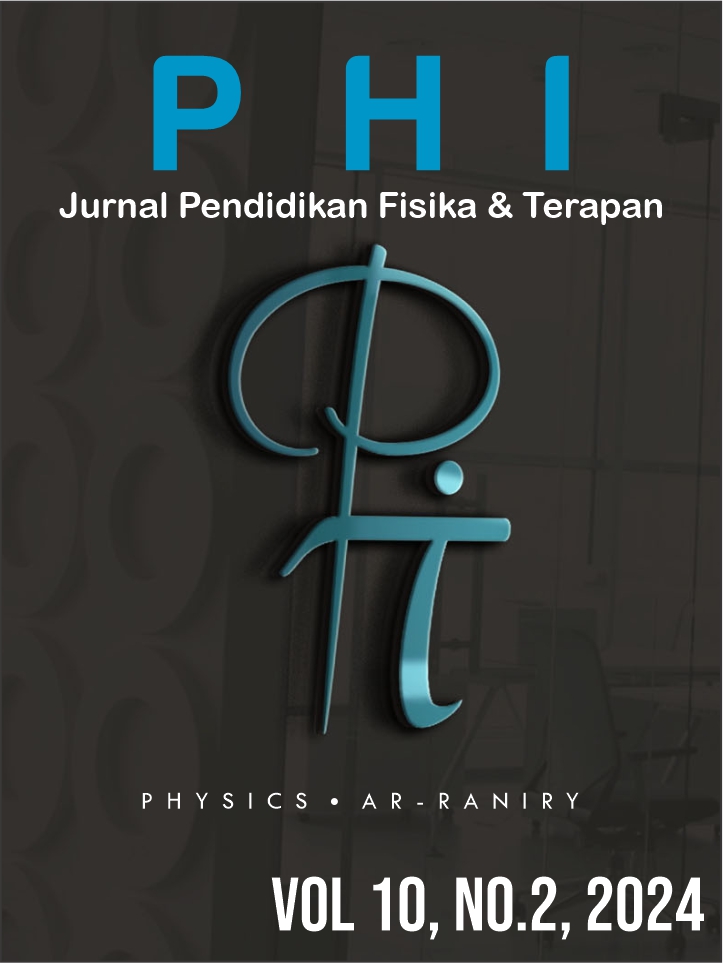DEVELOPMENT OF INTERACTIVE PHYSICS LEARNING VIDEOS BASED ON SCIENCE ENVIRONMENT TECHNOLOGY SOCIETY AT THE HIGH SCHOOL LEVEL
DOI:
https://doi.org/10.22373/p-jpft.v10i2.24939Keywords:
Learning Videos, Interactive Physics, Science Environtment Technology SocietyAbstract
This research is motivated by the use of learning methods that are still monotonous and uninteresting, the discussion of one of the physics materials that is difficult for students to understand, namely static fluid materials. This results in students having difficulty understanding the concepts and equations contained in static fluid materials. To overcome this problem, an interactive physics learning video based on the Science Environment Technology Society (SETS) was developed in order to provide students with an understanding of static fluid materials and become a digital media that can be used in the long term because it is flexible so that it can be used anywhere to repeat static fluid materials. The objectives of this research are: (1) To design interactive physics learning videos based on SETS at the high school/MA level; (2) To find out the feasibility of interactive physics learning videos based on SETS at the high school/MA level and (3) To find out the practicality of interactive physics learning videos based on SETS at the high school/MA level. This study uses the Research and Development (R&D) method based on the Alessi and Trollip development model. In this study, a product was produced in the form of interactive physics learning videos based on SETS. The results of the study show that SETS-based interactive physics learning videos have met the category of very feasible. This is determined based on the results of validation from media experts with a percentage of 90.4% included in the "very feasible" criteria and the validation results from material experts obtained a percentage of 91.2% with the "very feasible" criteria and user validation results with a percentage of 93.2% with the "very feasible" criteria. The results of the practicality assessment by students received a percentage of 95% with the category "very practical" used in the learning process. Thus, it can be concluded that SETS-based learning videos can be used in the learning process.References
Abdul Azis., et al. 2020. Physics of Static Fluid Module. (Surabaya: PPG Physics batch 2 Catholic University)
Alessi & Trollip, 2001. Multimedia for Learning: Methods and Development. (Massachussets: A Person Education), h. 407-413.
Anggi Angelia. 2017. Development of Physics Module with Science Environment, Technology, And Society (SETS) Approach for Class VIII Junior High School Motion and Force Materials. (Padang UIN Imam Bonjol) p. 19
I Gusti Putu Sudiarta and I Wayan Sadra, 2016. "The Effect of the Blende Learning Model Assisted by Animated Videos on Students' Problem-Solving Skills and Concept Understanding". Journal of Education and Teaching. Vol. 49, No. 2, p. 53.
Ismalik Perwira Admadja and Eko Marpanaji, 2016. "Multimedia Development of Individual Practice Learning Basic Instruments for Vocational School Students in the Field of Karawitan Expertise". Journal of Vocational Education. Vol. 6, No. 2, p. 176
Nabila Amalia Dewi, Hadi Nasbey. 2023. "Development of learning videos based on I-Sets assisted by Powtoon on class XI thermodynamics material". Proceedings of the National Seminar on Physics (E-Journal), Vol XI. h 330
Nabila Amalia Dewi, Hadi Nasbey. 2023. "Development of learning videos based on I-Sets assisted by Powtoon on class XI thermodynamics material". Proceedings of the National Seminar on Physics (E-Journal), Vol XI. H 330
Syarifah Hafizah, 2020. "The Use and Development of Videos in Physics Learning", Journal of Physics Education, Vol. VIII. No.2. September. H. 226
Wisnu Ady Prasetya, Ignatius I Wayan Suwatra and Luh Putu Putrini Mahadewi, 2021. "Animation Video Development Learning in Mathematics Subjects". Journal of Educational Development Research, Vol. 5, No. 1, p. 61.
Downloads
Published
Issue
Section
License
Authors who publish with Jurnal Phi agree to the following terms:
- Authors retain copyright and grant the journal right of first publication with the work simultaneously licensed under a Creative Commons Attribution License (CC BY 4.0) that allows others to share the work with an acknowledgment of the work's authorship and initial publication in this journal.
- Authors are able to enter into separate, additional contractual arrangements for the non-exclusive distribution of the journal's published version of the work (e.g., post it to an institutional repository or publish it in a book), with an acknowledgment of its initial publication in this journal.
- Authors are permitted and encouraged to post their work online (e.g., in institutional repositories or on their website) prior to and during the submission process, as it can lead to productive exchanges, as well as earlier and greater citation of published work (See The Effect of Open Access).

















